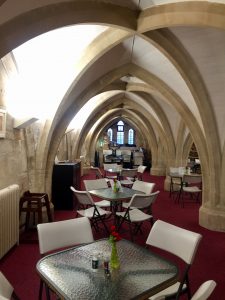Coffee in the Crypt
Every January, the first-year fellows of the Winterthur Program and several students in MA and PhD programs from the University of Delaware take part in British Design History: a three-week course on design and material culture with one week at Winterthur and a two-week field study in Great Britain. Traveling to cities including London, Stoke-on-Trent, and Bath, the students have an opportunity to study American Material Culture within a greater global context. Students’ posts in this section are centered on their experiences in England or working with British objects in the Winterthur collection.
Upon first glance at one of England’s magnificent parish churches, your first instinct is to look up to the heavens at an intricately designed vaulted ceiling or straight ahead at an awe-inspiring altar. This is, after all, how its architect would have designed it, your eyes immediately drawn to God. However, if you look, hidden beneath the ground, these churches have also taken on a more contemporary role.
Though we later found many scattered around the city, we saw our first crypt adaptively reused as a cafe at Christ Church, Spitalfields. Down the stairs and around the corner from the entrance, we found caffeine and a refuge from the cold and rain during a walking tour of the East End with Angus Lockyer, a lecturer at the School for Oriental and African Studies at the University of London. We found examples again with Peter Guillery, Principal Investigator, Senior Researcher, Historian and Editor at the Survey of London at St. Mary-le-Bow, the humbly-designed Queen of London parish church, and at St. Mary Redcliffe in Bristol, to name just a few. At St. Mary-le-Bow, “Café Below” has operated for nearly three decades.
According to Lockyer, these cafes provide their historic tenants with a steady source of income to help offset the expenses of maintaining and making improvements, no small feat when it comes to the large, towering structures. Others seemed to focus more on using the space as a community center, selling local artwork and hosting events like live jazz and barbecues on the lawn. No matter their offerings, we found a bustling business amidst ancient architecture and burials.

In addition to coffee and light fare, Café Arc displayed local artwork for sale and advertised for live jazz performances and barbecues on the lawn.
Though I must admit that I’ve spent fairly little time really studying the preservation of American churches, the idea of “Coffee in the Crypt” was a brand new one for me. As a graduate student in Urban Affairs & Public Policy and Historic Preservation, my interest began but didn’t end at the readily available caffeine and instead gave me something to sip on. Does England have something here? Could coffee and pastries help bring life back to some of the United States’ many untrafficked and deteriorating churches?
By Kaitlyn N. Laws, Master’s Candidate in Urban Affairs & Public Policy, University of Delaware




Leave a Reply